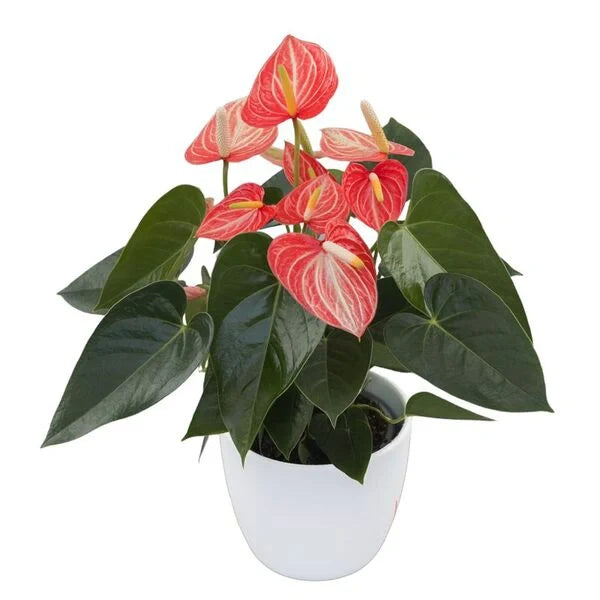
Anthurium Livium - Double Shoot
Selling Size : Please Choose | Pot Included | secure Packing
Anthurium 'Livium' is a stunning cultivar known for its unique, often striped or mottled spathes (the colorful, heart-shaped parts that look like flowers). Like other anthuriums, it's a tropical plant that thrives when its indoor environment mimics its natural rainforest habitat.
Here's a detailed care guide for your Anthurium 'Livium' :
1. Light:
Bright, indirect light is paramount. This is crucial for both vibrant spathe color and consistent blooming. Think of the dappled light it would receive under a tree canopy in the jungle.
Avoid direct sunlight, especially the intense afternoon sun in India. Direct sun will scorch the leaves and spathes, leading to bleached or brown spots.
Too little light will result in fewer blooms, muted colors, and leggy growth with smaller leaves.
Ideal placement: Near an east-facing window for gentle morning sun, or a few feet away from a south or west-facing window, with sheer curtains or blinds to filter the light. Rotate your plant occasionally for even growth.
2. Watering:
Water when the top 50-75% of the soil feels dry to the touch. This typically translates to once a week to every 10 days, but it's crucial to check the soil moisture, especially given India's varying temperatures and humidity. In hotter, drier periods, you might need to water more frequently.
Ensure excellent drainage. Anthuriums are very susceptible to root rot. Always use a pot with drainage holes. Water thoroughly until water drains from the bottom, then discard any excess water in the saucer immediately. Never let the plant sit in standing water.
Signs of improper watering:
Yellowing leaves (especially lower ones): Often a sign of overwatering.
Brown tips or edges on leaves/spathes: Can indicate underwatering or low humidity.
Drooping/wilting leaves: Can be caused by both overwatering (due to root rot) and underwatering (lack of moisture). Check the soil to confirm.
3. Humidity:
Anthurium 'Livium' absolutely loves high humidity (ideally 60-80% or higher). This is essential for preventing brown edges on its spathes and keeping the leaves lush.
Given India's climate, which can be quite humid during monsoons but dry in other seasons, you'll likely need to supplement humidity:
Use a humidifier: This is the most effective method for consistent humidity.
Pebble tray: Place the pot on a tray filled with pebbles and water, ensuring the pot itself doesn't sit in the water.
Misting: Mist the leaves regularly, especially during dry periods. Daily misting is beneficial.
Group plants: Grouping plants together creates a localized microclimate with higher humidity.
Location: Bathrooms or kitchens often have naturally higher humidity.
4. Temperature:
Maintain warm, consistent temperatures between 18∘C and 28∘C (65∘F and 82∘F).
Avoid temperatures below 15∘C (59∘F), cold drafts, or sudden temperature fluctuations. These can stress the plant, leading to yellowing leaves or stunted growth. Keep it away from air conditioning vents.
5. Soil and Potting:
Anthuriums are epiphytic in their natural habitat, meaning they grow on other plants rather than in dense soil. Therefore, they need a loose, airy, extremely well-draining, and slightly acidic potting mix. This prevents waterlogging and provides good aeration for their roots.
A good "aroid mix" or orchid mix is ideal, typically including:
Orchid bark/pine bark chips (for superb drainage and aeration)
Coco coir or peat moss (for moisture retention)
Perlite or pumice (for drainage and aeration)
A small amount of compost or vermicompost for nutrients.
Avoid dense, heavy potting mixes.
Repotting: Repot every 1-2 years, or when the plant becomes visibly root-bound. Choose a pot that is only slightly larger than the current one. They don't mind being a little snug.
6. Fertilizer:
Anthurium 'Livium' is a moderate feeder, especially during its active growing season (spring through summer/early autumn).
Use a balanced liquid fertilizer formulated for flowering plants (often higher in phosphorus, the middle number in NPK) diluted to half or quarter strength.
Fertilize every 2-4 weeks during the growing season.
Reduce or pause fertilization in the fall and winter when growth slows.
Always water the plant before fertilizing to prevent root burn.
7. Pruning:
Remove spent flowers (spathes) by cutting the stalk close to the base of the plant. This encourages the plant to produce new blooms.
Trim off any yellowing, brown, or damaged leaves to direct the plant's energy towards healthy growth. Use clean, sharp shears.
8. Pests and Diseases:
Anthuriums can occasionally be susceptible to common houseplant pests like spider mites, mealybugs, aphids, and thrips.
Inspect your plant regularly, especially the undersides of leaves.
Treat any infestations promptly with insecticidal soap or neem oil.
Root rot is the most common disease, caused by overwatering and poor drainage. Ensuring the right watering practices is vital.
Good air circulation can help prevent fungal issues.
9. Toxicity:
Like all Anthuriums, 'Livium' contains calcium oxalate crystals and is toxic if ingested by pets or humans. It can cause irritation to the mouth and digestive tract. Keep it out of reach of curious children and pets.
By providing these consistent care conditions, your Anthurium 'Livium' will flourish and reward you with its unique and long-lasting colorful spathes, adding a tropical touch to your home in India.

